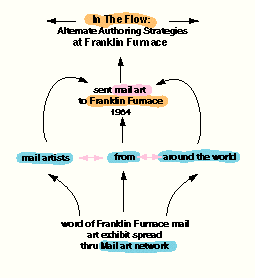Perhaps more than
any other genre, Mail Art as an international movement consciously promotes Marshal McLuhan's adage, "the
medium is the message." Beyond the impact of the drawings, collages,
stamps, xeroxes, or objects which are the visual content, the artist-to-artist network through which
the art is passed asserts it's opposition to conventional distribution through gallery, publishing
and museum systems. Ray Johnson's rubber stamp: "PLEASE ADD TO AND RETURN
TO RAY JOHNSON" found on many of his mailings both proposes an authoring
strategy often used in mail art (a variation of the collaborative relay
mode popularized in the "exquisite corpse"
by the Surrealists) and it is also an admonishment to see the art as something to be experienced
and transferred rather than possessed.
If it is true that information about the knowledge of all modern art
research is more than any one artist could comprehend, then the concept
of the avant-garde is obsolete. With incomplete knowledge, who can say
who is in front, and who ain't. I suggest that considering each artist
as part of an Eternal Network is a much more useful concept.
--Robert Filliou in a 1973 issue of FILE magazine quoted in Mail Art:
An Annotated Bibliography by John Held Jr. Scarecrow Press, Metuchen NJ
1991 p. xxiv
In the sixties, seventies and eighties, The Eternal Network of Mail art also known as the "N -tity"
had already considered many of the implications of free exchange of images
as information instead of as commodities which are now arising on-line in the context
of the World Wide Web:
The N -tity has become the historical now & is upon us. None of
us can control it, all of us Navigate it. Concurrent, coalescing energy,
the N -tity is all that we share N common.
The N -tity is the vanguard expression of the explosion in the means
of communication & the consequential response to this fact, & the
continuing shrinkage, of time & space.
--Carlo Pittore "The N -tity" Mail Art Then And Now, Flue
magazine Volume 4, winter 1984, Franklin Furnace, p32.
Rather than the creation of one world culutre, mail art is showing that
a respect for divergent ideas can be a powerful stratagem in reconciling
multinational differences, and that specific cultures can interact in "open
situations" where each cultural representation can make important
contributions in an integrated process of creation.
Five decades after Ray Johnson developed his moticos mailing list, mail
art has escaped the rigid boundaries of the artworld, and yet it still
has lessons to impart to the mainstream art establishment. It confirms
the idea that art is everywhere and that everyone can be creative given
the opportunity to do so; that art is decentralized and does not depend
on controlling opinions emanating from centralized world centers, Indeed,
the diffusion of ideas is more potent and varied when it originates from
the base of a pyramid rather than the summit.
--John Held Jr., op cit. p. xxii.
The opposition to institutional and market culture of art by the Eternal
Network extended to Mail art exhibitions as well.
In the middle seventies, the mail art show came to mean "all work
shown," "no fees to enter," and "documentation to all
participants." Sensing that something important was happening, yet
receving little support from the art establishment, mail artists took it
upon themselves to curate their own shows and thus insure the growth of
their preferred medium.
--ibid p. xxiv
This norm was tested in 1984 when curator Ronny Cohen organized an exhibition
for Franklin Furnace called Mail Art Then and Now. As the title suggests
it was to have an historical aspect as well as showing new mail art. To
mediate the two aspects, Cohen wanted to edit the new mail art sent to
Franklin Furnace which would be displayed. Though in the end, all the work
received was shown, the intent to edit created a "public display of
emotion" at an Artists Talk on Art conference in February of 1984
where many mail artists confronted each other in person to debate the issues
raised by the exhibition.
Since In The Flow is not a mail art exhibition per se, we are showing some though not all of the Mail art which Franklin Furnace
received in 1984 for the exhibition. The system of distribution again compromises the art, but we wish to acknowledge them as examples of an early network medium
and to remember the issues of the controversy which pertain to the institutional,
political and esthetic assumptions which often underlie presentation space
even in a place as "alternative" as Franklin Furnace has been for
twenty years.
The following links lead to writings from Flue, Volume 4 Issue 3, published
by Franklin Furnace as the catalogue for "Mail Art Then and Now" Ronny
Cohen Curator and guest editor:
On Mail Art: Doo-da postage Works by E.F.
Higgins III
Illegal Mail Art (a poetical essay) by Valery
Oisteanu
N-tity by Carlo Pittore

